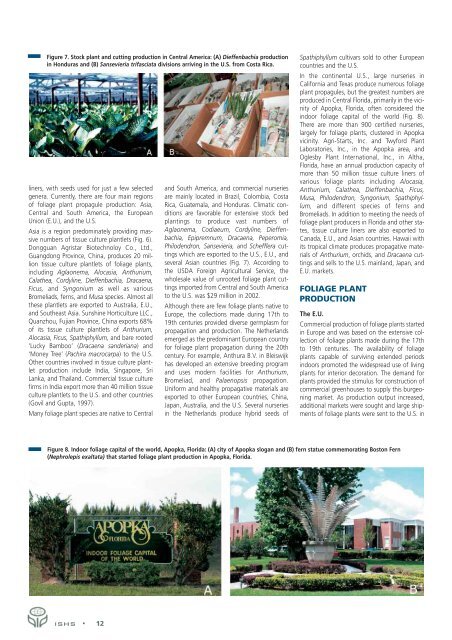The World Foliage Plant Industry - Acta Horticulturae
The World Foliage Plant Industry - Acta Horticulturae
The World Foliage Plant Industry - Acta Horticulturae
Create successful ePaper yourself
Turn your PDF publications into a flip-book with our unique Google optimized e-Paper software.
Figure 7. Stock plant and cutting production in Central America: (A) Dieffenbachia production<br />
in Honduras and (B) Sansevieria trifasciata divisions arriving in the U.S. from Costa Rica.<br />
liners, with seeds used for just a few selected<br />
genera. Currently, there are four main regions<br />
of foliage plant propagule production: Asia,<br />
Central and South America, the European<br />
Union (E.U.), and the U.S.<br />
Asia is a region predominately providing massive<br />
numbers of tissue culture plantlets (Fig. 6).<br />
Dongguan Agristar Biotechnoloy Co., Ltd.,<br />
Guangdong Province, China, produces 20 million<br />
tissue culture plantlets of foliage plants,<br />
including Aglaonema, Alocasia, Anthurium,<br />
Calathea, Cordyline, Dieffenbachia, Dracaena,<br />
Ficus, and Syngonium as well as various<br />
Bromeliads, ferns, and Musa species. Almost all<br />
these plantlets are exported to Australia, E.U.,<br />
and Southeast Asia. Sunshine Horticulture LLC.,<br />
Quanzhou, Fujian Province, China exports 68%<br />
of its tissue culture plantlets of Anthurium,<br />
Alocasia, Ficus, Spathiphyllum, and bare rooted<br />
‘Lucky Bamboo’ (Dracaena sanderiana) and<br />
‘Money Tree’ (Pachira macrocarpa) to the U.S.<br />
Other countries involved in tissue culture plantlet<br />
production include India, Singapore, Sri<br />
Lanka, and Thailand. Commercial tissue culture<br />
firms in India export more than 40 million tissue<br />
culture plantlets to the U.S. and other countries<br />
(Govil and Gupta, 1997).<br />
Many foliage plant species are native to Central<br />
and South America, and commercial nurseries<br />
are mainly located in Brazil, Colombia, Costa<br />
Rica, Guatemala, and Honduras. Climatic conditions<br />
are favorable for extensive stock bed<br />
plantings to produce vast numbers of<br />
Aglaonema, Codiaeum, Cordyline, Dieffenbachia,<br />
Epipremnum, Dracaena, Peperomia,<br />
Philodendron, Sansevieria, and Schefflera cuttings<br />
which are exported to the U.S., E.U., and<br />
several Asian countries (Fig. 7). According to<br />
the USDA Foreign Agricultural Service, the<br />
wholesale value of unrooted foliage plant cuttings<br />
imported from Central and South America<br />
to the U.S. was $29 million in 2002.<br />
Although there are few foliage plants native to<br />
Europe, the collections made during 17th to<br />
19th centuries provided diverse germplasm for<br />
propagation and production. <strong>The</strong> Netherlands<br />
emerged as the predominant European country<br />
for foliage plant propagation during the 20th<br />
century. For example, Anthura B.V. in Bleiswijk<br />
has developed an extensive breeding program<br />
and uses modern facilities for Anthurium,<br />
Bromeliad, and Palaenopsis propagation.<br />
Uniform and healthy propagative materials are<br />
exported to other European countries, China,<br />
Japan, Australia, and the U.S. Several nurseries<br />
in the Netherlands produce hybrid seeds of<br />
Spathiphyllum cultivars sold to other European<br />
countries and the U.S.<br />
In the continental U.S., large nurseries in<br />
California and Texas produce numerous foliage<br />
plant propagules, but the greatest numbers are<br />
produced in Central Florida, primarily in the vicinity<br />
of Apopka, Florida, often considered the<br />
indoor foliage capital of the world (Fig. 8).<br />
<strong>The</strong>re are more than 900 certified nurseries,<br />
largely for foliage plants, clustered in Apopka<br />
vicinity. Agri-Starts, Inc. and Twyford <strong>Plant</strong><br />
Laboratories, Inc., in the Apopka area, and<br />
Oglesby <strong>Plant</strong> International, Inc., in Altha,<br />
Florida, have an annual production capacity of<br />
more than 50 million tissue culture liners of<br />
various foliage plants including Alocasia,<br />
Anthurium, Calathea, Dieffenbachia, Ficus,<br />
Musa, Philodendron, Syngonium, Spathiphyllum,<br />
and different species of ferns and<br />
Bromeliads. In addition to meeting the needs of<br />
foliage plant producers in Florida and other states,<br />
tissue culture liners are also exported to<br />
Canada, E.U., and Asian countries. Hawaii with<br />
its tropical climate produces propagative materials<br />
of Anthurium, orchids, and Dracaena cuttings<br />
and sells to the U.S. mainland, Japan, and<br />
E.U. markets.<br />
FOLIAGE PLANT<br />
PRODUCTION<br />
<strong>The</strong> E.U.<br />
Commercial production of foliage plants started<br />
in Europe and was based on the extensive collection<br />
of foliage plants made during the 17th<br />
to 19th centuries. <strong>The</strong> availability of foliage<br />
plants capable of surviving extended periods<br />
indoors promoted the widespread use of living<br />
plants for interior decoration. <strong>The</strong> demand for<br />
plants provided the stimulus for construction of<br />
commercial greenhouses to supply this burgeoning<br />
market. As production output increased,<br />
additional markets were sought and large shipments<br />
of foliage plants were sent to the U.S. in<br />
Figure 8. Indoor foliage capital of the world, Apopka, Florida: (A) city of Apopka slogan and (B) fern statue commemorating Boston Fern<br />
(Nephrolepis exaltata) that started foliage plant production in Apopka, Florida.<br />
ISHS • 12

















